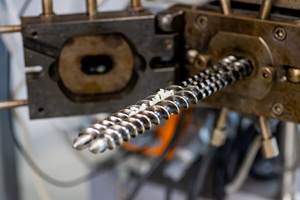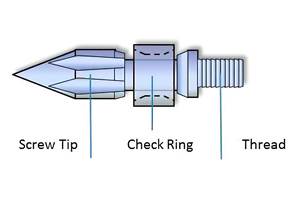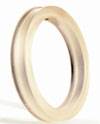Purging High-Performance Engineering Resins
Purging Tips: Part I
One of the fastest growing markets for commercial purging compounds is purging high-performance engineering resins. It is also one of the most difficult challenges, since both mechanical and chemical purging compounds have limitations when it comes to heat stability, residence time, flow restrictions, etc.
High-performance engineering resins, originally designed for aerospace, can now be found in electrical/electronic, telecommunications, chemical, and medical industries. Each market shares a growing need to utilize thermoplastics that offer higher temperature resistance, strength, dimensional stability, and chemical resistance. More recently, the automotive industry has also started to use high-performance engineering resins due to pressing needs for more durability and lightweighting.
High-performance, high-heat thermoplastics generally process at melt temperatures in the range of 520 to 800 F (271 to 426 C). Examples include liquid-crystal polymers (LCP), polyamide-imide (PAI), PEEK, polyetherimide (PEI), polyethersulfone (PES) polyimide (PI), polyphenylsulfone (PPSU), polyphthalamide (PPA), and polysulfone (PSU). These all share a common problem when it comes to purging: The cost of these resins is often in excess of $5/lb and thus minimizing scrap has become critical. As a result, one of the fastest growing markets for commercial purging compounds is purging high-performance engineering resins. It is also one of the most difficult challenges, since both mechanical and chemical purging compounds have limitations when it comes to heat stability, residence time, flow restrictions, etc.
The following recommendations are designed to optimize your high-temperature purging experience, keeping in mind that safety always comes first. Make sure to follow your own company’s safety guidelines:
Tip #1: Use a commercial purge compound designed for high temperatures. Commercial purging compounds (CPCs) are significantly less expensive and more effective than purging with the engineering resins themselves. CPCs are formulated specifically for purging. However, it is important to use a purging compound that is designed for high temperatures. The carrier resins utilized in these CPCs are generally high-molecular-weight polymers with good thermal stability. CPCs are designed for mechanical or chemical purging action. Modification of purging procedures is often recommended for high-temperature operation, particularly for chemical-type CPCs. Consult with your purging compound provider to be sure that you are using the correct grade and procedure.
Tip #2: Purge at the lower end of the recommended resin melt-temperature range. Be mindful of the actual resin melt temperature, which may be higher than the barrel-temperature readings. Lowering barrel temperature and, in some cases, lowering screw rpm will reduce the melt temperature. Lowering the purge temperature is recommended by major engineering resin suppliers, including BASF, Sabic, Solvay, and Victrex. Purge compounds are usually more effective at the lower temperatures. Operating at the lower range is also safer for operators.
Tip #3: Keep purge piles small, flat, and thin to minimize fumes. Fumes can also be minimized by purging into water or putting the piles into water immediately after purging to cool them. Use of local ventilation or other engineering controls is strongly recommended to keep air contaminants below statutory levels for both the resins and the purging compound.
Tip #4: Keep the barrel full to minimize degradation. With heat and oxygen present, resins and purge compounds will degrade. The higher the temperature, the faster they will degrade. Keeping the barrel full will reduce exposure to oxygen and therefore reduce the chance for degradation to occur.
Tip #5: Do not leave purge in the barrel at high temperatures for an extended time. Consult your CPC supplier for actual time and temperature recommendations, but a maximum of 30 minutes is a general guideline.
Tip #6: Keep the feed throat cool to prevent “balling up” of CPC in the throat. The temperature of the feed-throat coolant should be maintained at 80-120 F (27-49 C). It is best to control the feed-throat temperature as close to 100 F (38 C) as possible. In humid weather, the temperature should be just warmer than the dewpoint to avoid condensation.
Tip #7: If shutting down or transitioning to another resin with a lower operating range, bring temperatures down as quickly as possible. This will enhance the purging process and prevent degradation of the next resin.
Related Content
The Power of Self-Emptying Technology for Extrusion Lines
Advanced purging compounds can save you time, frustration, and cost.
Read MoreNeutrex Names John R. Haag President, CEO
Haag has played an integral role in the founding of Neutrex in 1992 and served the company for three decades as general counsel.
Read MoreGot Streaks or Black Specs? Here’s How to Find and Fix Them
Determining the source of streaking or contamination in your molded parts is a critical step in perfecting your purging procedures ultimately saving you time and money.
Read MoreAsahi Kasei Plastics North America Merges with Asahi Kasei Asaclean Americas
Merged entity to further boost best-in-class manufacturing services.
Read MoreRead Next
Better Purging Saves Money, Material and Time
How much money can a better purging compound save even a small molder?
Read MoreLead the Conversation, Change the Conversation
Coverage of single-use plastics can be both misleading and demoralizing. Here are 10 tips for changing the perception of the plastics industry at your company and in your community.
Read MoreRecycling Partners Collaborate to Eliminate Production Scrap Waste at NPE2024
A collaboration between show organizer PLASTICS, recycler CPR and size reduction experts WEIMA and Conair will seek to recover and recycle 100% of the parts produced at the show.
Read More






 (2).jpg;maxWidth=300;quality=90)















